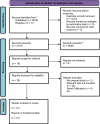Tricuspid valve replacement with mechanical versus biological prostheses: a systematic review and meta-analysis
- PMID: 39587673
- PMCID: PMC11590259
- DOI: 10.1186/s13019-024-03014-0
Tricuspid valve replacement with mechanical versus biological prostheses: a systematic review and meta-analysis
Abstract
Background and objective: Tricuspid valve replacement (TVR) is required when repair is not feasible, and it continues to be a relatively high-risk procedure owing to the complex medical and/or surgical profile of patients. The choice between mechanical and biological prostheses for TVR remains a subject of debate owing to their distinct advantages and disadvantages. This study aimed to analyse and compare the clinical outcomes of these two types of prostheses in the tricuspid position.
Methods: PubMed, EMBASE, Web of Science, and the COCHRANE library were searched from 1995 to April 2023 for studies comparing clinical outcomes of mechanical versus biological valves in the tricuspid position. Data on 30-day mortality, reoperations, 5-year valve failure rates, thrombotic/thromboembolic events, and long-term survival were extracted, pooled, and analysed. Forest plots were generated using a random-effects model.
Results: From an initial pool of 4716 citations, 37 studies meeting our inclusion criteria were assessed, collectively encompassing 8316 prostheses (3796 mechanical, 4520 bioprostheses). Our analysis revealed that mechanical valves exhibited a non-significant trend towards diminished 30-day mortality (RR = 0.85, 95% CI = 0.69-1.06). A distinct disparity emerged in valve durability, with mechanical valves demonstrating a significantly increased risk of 5-year valve failure (RR = 2.21, 95% CI = 1.38-3.56). Strikingly, mechanical valves displayed a substantial six-fold elevated risk of thrombotic events (RR = 6.29, 95% CI = 3.98-9.92). In contrast, the long-term survival and reoperation rates demonstrated no statistically significant differences between the two valve types.
Conclusions: This systematic review and meta-analysis provides insights into the selection of mechanical and bioprosthetic valves for TVR. These findings highlight the potential advantages and disadvantages of mechanical and bioprosthetic valves in terms of early mortality, valve durability, and thrombotic risk. Our analysis provides clinicians with evidence-based guidance for optimizing outcomes in TVR, offering a foundation for informed decision-making in this intricate surgical landscape. Despite these insights, clinicians must overcome the limitations of retrospective studies, evolving healthcare, and anticoagulant disparities to ensure careful consideration in tricuspid valve replacement decisions.
Keywords: Bioprosthetic valve; Clinical outcomes; Long term survival; Mechanical valve; Meta-analysis; Mortality; Tricuspid valve replacement.
© 2024. The Author(s).
Conflict of interest statement
Declarations. Ethics approval and consent to participate: Not Applicable. Competing interests: The author Sameh M. Said is a consultant for Artivion, Abbott, and JOMDD.
Figures







Similar articles
-
Mechanical versus bioprosthetic valve for aortic valve replacement in dialysis patients: Systematic review and individual patient data meta-analysis.Asian Cardiovasc Thorac Ann. 2024 Nov;32(8-9):484-493. doi: 10.1177/02184923241301108. Asian Cardiovasc Thorac Ann. 2024. PMID: 39615043
-
Limited versus full sternotomy for aortic valve replacement.Cochrane Database Syst Rev. 2017 Apr 10;4(4):CD011793. doi: 10.1002/14651858.CD011793.pub2. Cochrane Database Syst Rev. 2017. Update in: Cochrane Database Syst Rev. 2023 Dec 6;12:CD011793. doi: 10.1002/14651858.CD011793.pub3. PMID: 28394022 Free PMC article. Updated.
-
Systemic pharmacological treatments for chronic plaque psoriasis: a network meta-analysis.Cochrane Database Syst Rev. 2021 Apr 19;4(4):CD011535. doi: 10.1002/14651858.CD011535.pub4. Cochrane Database Syst Rev. 2021. Update in: Cochrane Database Syst Rev. 2022 May 23;5:CD011535. doi: 10.1002/14651858.CD011535.pub5. PMID: 33871055 Free PMC article. Updated.
-
Long-term outcomes after bioprosthetic tricuspid valve replacement: a multicenter study.Eur J Cardiothorac Surg. 2025 Mar 28;67(4):ezaf107. doi: 10.1093/ejcts/ezaf107. Eur J Cardiothorac Surg. 2025. PMID: 40128150
-
Mechanical Versus Bioprosthetic Valve Replacement in the Tricuspid Valve Position: A Systematic Review and Meta-Analysis.Heart Lung Circ. 2021 Mar;30(3):362-371. doi: 10.1016/j.hlc.2020.03.011. Epub 2020 Apr 1. Heart Lung Circ. 2021. PMID: 33229238
Cited by
-
A case of complete atrioventricular septal defect in which extracorporeal membrane oxygenation could be removed after performing the bilateral Glenn procedure for severe cardiac dysfunction after tricuspid valve replacement: a case report.BMC Pediatr. 2025 Apr 16;25(1):302. doi: 10.1186/s12887-025-05654-0. BMC Pediatr. 2025. PMID: 40241091 Free PMC article.
-
Impact of Right Atrial Plication on Pulmonary Function and Heart Failure Symptoms: A Case Report.Cureus. 2024 Dec 26;16(12):e76447. doi: 10.7759/cureus.76447. eCollection 2024 Dec. Cureus. 2024. PMID: 39867020 Free PMC article.
-
Stented Biological Prosthesis Versus Mitral Allograft in Surgical Treatment of Tricuspid Valve Infective Endocarditis.Rev Cardiovasc Med. 2025 Jul 8;26(7):37204. doi: 10.31083/RCM37204. eCollection 2025 Jul. Rev Cardiovasc Med. 2025. PMID: 40776959 Free PMC article.
References
-
- Iscan ZH, Vural KM, Bahar I, Mavioglu L, Saritas A. What to expect after tricuspid valve replacement? Long-term results. Eur J Cardiothorac Surg. 2007;32(2):296–300. - PubMed
-
- Van Nooten GJ, Caes F, Taeymans Y, Van Belleghem Y, François K, De Bacquer D, et al. Tricuspid valve replacement: Postoperative and long-term results. J Thorac Cardiovasc Surg. 1995;110(3):672–9. - PubMed
-
- Mangoni AA, DiSalvo TG, Vlahakes GJ, Polanczyk CA, Fifer MA. Outcome following isolated tricuspid valve replacement. Eur J Cardiothorac Surg. 2001;19(1):68–73. - PubMed
-
- Filsoufi F, Anyanwu AC, Salzberg SP, Frankel T, Cohn LH, Adams DH. Long-term outcomes of tricuspid valve replacement in the current era. Ann Thorac Surg. 2005;80(3):845–50. - PubMed
Publication types
MeSH terms
LinkOut - more resources
Full Text Sources
Miscellaneous

